Modeling dynamic kill requirements for hole size and kill-mud volumes leads to the safe drilling of an Erha Field pilot hole.
Enrique Garcia, Jay Akers and Jesse Holster, ExxonMobil Development Co.
The Erha-7 well is a deepwater exploration test that was drilled in 1,074-m water depth within Nigeria’s Offshore Mining License (OML) 133, formerly OPL-209, Fig. 1. During the early well planning process, the site investigation team identified numerous stacked shallow hazards surrounding the well’s geologic targets. These were evaluated by the drill team, the site investigation team and the business unit to optimize the well location and minimize the risk from shallow, gas-charged sands. This article discusses the shallow hazards planning involved, and presents the modeling and evaluation of shallow gas flows and dynamic kills used to quantify the benefits of drilling a pilot hole.
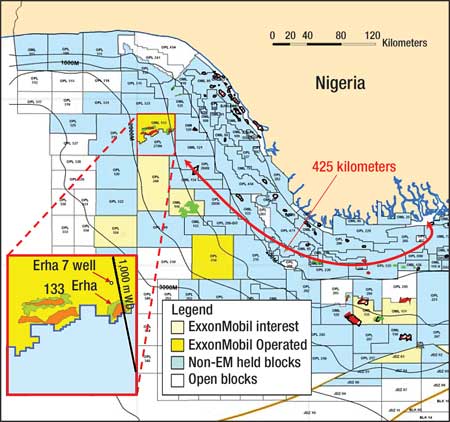 |
|
Fig. 1. The Erha-7 well is in Erha Field, Block OML 133, offshore Nigeria.
|
|
Erha Field was discovered in 1999. The Erha-7 well was a near-field wildcat designed to test a prospective hydrocarbon accumulation north of the main field. Site investigation revealed numerous high-amplitude seismic anomalies associated with three different stratigraphic intervals and depths Below the MudLine (BML). The well was positioned on the proximal margin of a large, sediment-filled, confined-channel complex. The complex consisted of multiple stacked channels that had migrated laterally through time, making it difficult to find a location within reach of the Erha-7 reservoirs that would not penetrate potentially gas-charged shallow sands, Fig. 2. Seismic data attenuation below high amplitudes in the complex and limited lateral resolution complicated the task.
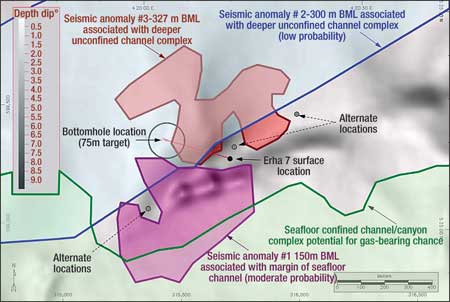 |
|
Fig. 2. Potential shallow hazards surrounding the Erha-7 location show three seismic amplitude anomalies and associated risk of gas-bearing sands at three different depths.
|
|
After evaluating alternatives, the final well path was planned to avoid intersecting high-amplitude anomalies. However, a low-to-moderate risk of encountering gas-charged sands remained. Three possible hazards were identified:
- 150 m BML (1,250 m RKB): thin sand with potential shallow gas, 50 m south of location, low risk of high volume
- 300 m BML (1,400 m RKB): ~ 9.0 ppge overpressured gas, 80 m northwest of location, low risk of high volume
- 327 m BML (1,427 m RKB): ~ 8.7 ppge overpressured gas, 35 m northwest of location, moderate risk of high volume.
An alternative well design was considered in which 20-in. casing would be set above the shallow anomalies at 300 m and 327 m BML. This design would allow a BOP and riser to be run and drill the anomalies using weighted mud. However, the low formation integrity at this depth would likely result in a broaching situation in any well control or kill operation. The safety of the rig would be enhanced by drilling the shallow hazards without the BOP and riser. This allows a rapid departure from the location should the situation deteriorate.
Alternate locations were identified as far as 2.5 km from the well’s target objectives, but all alternate locations had similar risks. Unable to eliminate shallow hazard risk, the drill team examined industry experience and evaluated the safest and most cost-effective approach to drilling the riserless interval.
SAFETY CONSIDERATIONS
Shallow gas has long plagued the drilling industry. Gas blowouts (shallow gas or otherwise) near floating drilling vessels have drawn the attention of the oil and gas industry because of the concern that vessels may lose buoyancy in the gas plume. However, examples of floaters surviving subsea gas blowouts are numerous, including the West Vanguard at Haltenbanken in the Norwegian Sea, the Doo Sung offshore Korea and the Actinia offshore Vietnam.
No published information or case histories exist of a shallow gas blowout in deepwater (>1,000 m water depth). The lack of incidents may be due to improved shallow gas identification and avoidance or operational planning and execution. The dearth of published information of case histories results in reliance on computer simulations of deepwater shallow gas blowouts, which reveal that gas reaching the sea surface is unlikely to compromise floater safety. Gas is likely to dissolve in the water column and/or disperse to such an extent that explosive concentrations at the sea surface are difficult to attain.
Although loss of buoyancy has not been found to be a significant concern, it is more significant for drillships than semisubmersibles. Ultimately, any rig stability issues are more likely associated with high surface currents than with buoyancy loss.
The team concluded that even a relatively high-rate gas release in Erha-7 water depth would pose little or no explosion hazard or vessel stability issues to the rig. Use of the dynamically positioned drillship, Deepwater Discovery, selected to drill this well, would facilitate a quick departure from the well location, if necessary.
MODELING AND DYNAMIC KILL OPERATIONS
Shallow hazard flow and dynamic kill simulations were done to evaluate the best mitigating factors for a successful kill. Modeling assumed shallow hazards were penetrated during riserless drilling with seawater in both 9⅞-in. and 17½-in. hole sizes. The simulations calculated the volume of kill-weight mud required for an effective dynamic kill as a function of pump rates. The calculated kill-mud volume includes the volume required to fill the drillstring before injecting kill mud through the bit at the bottom of the well. Each simulation assumed that dynamic kill operations began 20 min. after well flow initiation - sufficient time for reservoir gas to completely unload the hole. This produced worst-case conditions of maximum gas flowrate. The simulations also included hole washout sensitivities:
- 9⅞-in. pilot hole washed out to 12 1⁄12 in.
- 9⅞-in. pilot hole washed out to 14 in.
- 17½-in. pilot hole washed out to 19¼ in.
The results of selected scenarios are shown in Fig. 3, where each scenario is represented by a curve indicating the expected minimum volume of kill mud required to execute the dynamic kill as a function of pump rate. This figure compares shallow hazard flow scenarios for a 9⅞-in. hole (washed out to 14 in.) and a 17½-in. hole (washed out to 19¼ in.), assuming similar reservoir permeability, porosity and penetration.
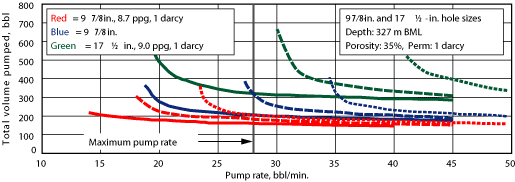 |
|
Fig. 3. Dynamic kill rate and volume requirements relative to different hole sizes and reservoir penetrations show which gas flows are killable.
|
|
The figure shows that higher pump rates reduce the overall kill-weight mud volume required to achieve a dynamic kill. Analyzing each curve reveals that the benefits of using higher pump rates are initially significant, and then rapidly decrease as the mud volume approaches the minimum required to achieve static bottomhole reservoir pressure. Conversely, lower pump rates require exponentially greater mud volumes. Thus, for each scenario, there is a minimum pump rate below which a dynamic kill is theoretically no longer possible.
Sensitivity modeling was also done for:
- Sand penetration below the top of the reservoir (2, 3 and 4 m)
- Reservoir pore pressure (8.7 and 9.0 ppg)
- Reservoir permeability (200, 500 and 1,000 mD)
- Hole size (7⅞-, 9⅞- and 17½-in. bit sizes).
Penetration. Because the maximum gas flowrate increases significantly with increased reservoir penetration, the minimum required pump rate is significantly higher for a 4-m penetration than for a 2-m penetration. The differences are significant enough to render a seemingly controllable scenario uncontrollable. Given the sensitivity to penetration depth, detailed shallow hazard detection plans are required to stop drilling progress and detect abnormal flow as early as possible after penetrating into a shallow gas zone.
Pore pressure. Figure 3 has two sets of curves for a 9⅞-in. hole scenario; one assumes an 8.7-ppg pore pressure equivalent (in red) and the other (in blue) assumes a 9.0-ppg pore pressure equivalent. The higher pore pressure results in a higher flowrate and greater annular velocities in the borehole. Accordingly, kill-weight mud must be introduced into the well more quickly to effect the dynamic kill. The mud volume required to conduct the dynamic kill in the higher pore pressure cases is only marginally greater than the volume for the lower pressure cases.
Permeability. Figure 4 illustrates the significant impact of permeability and reservoir penetration on the success of a dynamic kill for the 17½-in. bit because of its direct correlation with maximum gas flowrate. The figure shows total kh greater than about 2.75 darcy-meters for the 9.0-ppg case results in a flow that is unkillable with the pumping capacity of this rig. Similar curves were developed for a smaller 9⅞-in. pilot hole and slightly lower-pressured sand (8.73 ppg), Fig. 5. Modeling shows that total kh greater than about 10 darcy-meters is unkillable.
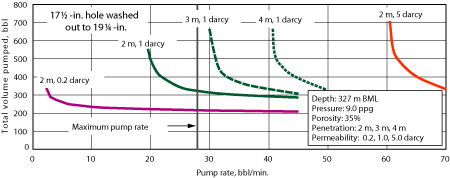 |
|
Fig. 4. A 17½-in. hole requires more kill mud to control a gas flow.
|
|
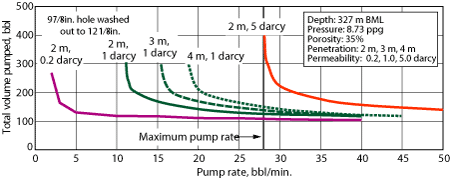 |
|
Fig. 5. There is a significant impact of permeability and reservoir penetration on the success of a dynamic kill because of its direct correlation with maximum gas flowrate.
|
|
Wellbore size. Examining these curves in light of the calculated maximum achievable pump rate for the Deepwater Discovery uncovers scenarios that are dynamically “killable.” Six of the nine curves in Fig. 3 lie to the left of the rig’s maximum achievable pump rate of about 28 bbl/min., and thus are “killable” scenarios. The benefits associated with a smaller wellbore were clear, given the curves associated with a 9.0-ppg reservoir pressure. Two of the three 9⅞-in. hole scenarios are killable, compared to only one of the 17½-in. hole scenarios.
For comparison, dynamic-kill modeling of a 7⅞-in. hole was also performed. Figure 6 compares dynamic-kill scenarios for 7⅞-in. and 9⅞-in. pilot holes and further demonstrates the advantage of a smaller hole. Note the similar killability of the 9⅞-in. hole and 7⅞-in. hole scenarios, where the latter assumes greater penetration (4 m vs. 2 m) and greater reservoir permeability (20 darcy vs. 5 darcy). Note that a similar inference can be made when comparing the killability of the 7⅞-in. hole scenarios, which vary in washout diameter. The team decided to pre-drill a 9⅞-in. pilot hole at Erha-7.
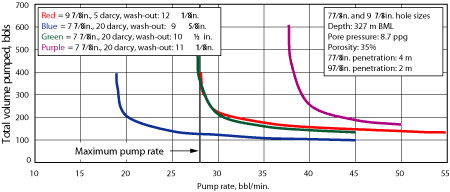 |
|
Fig. 6. The PAD mud dump scenario shows that at least an 11-ppg mud is required.
|
|
Mud volume. None of the 9⅞-in. hole scenarios modeled required more than 400 bbl of kill-weight mud to achieve a dynamic kill. The 17½-in. hole scenarios required no more than 700 bbl. These volumes represent about twice the volume of the washed-out hole. Hence, if the dynamic kill is not achieved within two to three hole volumes, the probability of success is dramatically reduced. These volumes require no more than 35 min. of pumping time at 15 to 20 bbl/min. The findings show the importance of achieving high pump rates and initiating dynamic-kill operations immediately following shallow-flow onset before extensive penetration and/or wellbore washout.
HYDRAULICS MODELING
The literature review and modeling made clear the need for speed in initiating a dynamic kill, and in pumping kill-weight mud to mitigate shallow hazards. The first point was addressed in the pilot-hole drilling procedure. The second required hydraulic modeling to determine maximum feasible pump rates. Optimum drilling-fluid properties require high-density, low-viscosity mud to achieve maximum pump rates, and flat gels for fluid handling and pumpability. After testing several different water-based, kill-weight drilling fluids, the team decided on a 15.0-ppg NaCl mud with polymer viscosifier and prehydrated bentonite yielding low 6/3 rpm readings of 13/16 and flat gel strengths of 13/15/18.
The model assumed that a differential U-tube pressure would help achieve higher rates than ordinary riser drilling, Fig 7. It did this by having seawater at hydrostatic on the backside vs. kill-weight fluid inside the drillstring. Theoretical pump rates exceeding 31 bbl/min. (1,300 gpm) were achievable. Pumping at these rates required 6-in. liners that were not available on the rig. Using the rig’s 6½-in. liners limited the maximum pump rate to about 28 bbl/min. (1,175 gpm).
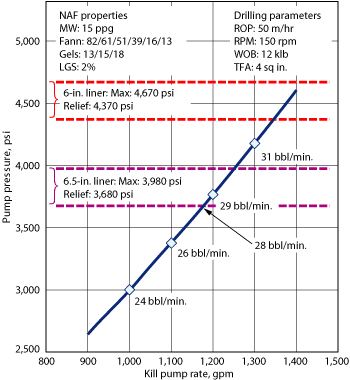 |
|
Fig. 7. A shallow gas flow would self-deplete within 10 to 60 days.
|
|
STUDY IMPLICATIONS
The modeling and engineering work performed resulted in several decisions for the Erha-7 well. Although the risk of encountering shallow gas was deemed low to moderate, a 9⅞-in. pilot hole was planned because of its superior dynamic-kill characteristics compared to a 17½-in. bore with no pilot hole. The time and cost of the pilot hole were justified by the risked cost of a shallow gas blowout lasting two months with the drillship standing by on location.
It was important to limit the penetration into the reservoir and to detect any kick early. The BHA would be designed to place the LWD as close to the bit as possible, and the rate of penetration would be limited to avoid drilling too far into the hazard. A high pump rate was more important than large kill mud volume.
The Deepwater Discovery had excess pit capacity compared to dynamic-kill mud volume requirements. The pumps would be able to achieve 28 bbl/min. with the 6½-in. liners, which was acceptable. Had more time been available, 6-in. liners would have been considered, which would have increased pump rate capacity to more than 31 bbl/min.
A pump-and-dump option had advantages because it maintained overbalance to the formation at all times. However, the logistics of supplying the required large fluid volume to this remote location rendered the option infeasible. If the well could not be killed and the rig had to be removed, the shallow hazard would deplete itself in less than two months.
SHALLOW HAZARD FLOW PLAN
A 9⅞-in. pilot hole procedure was prepared incorporating shallow hazard flow prevention and mitigation plans. Primary prevention steps included a thorough site investigation to optimize surface well positioning. The pilot hole was drilled at the final well position (not off location) with the intent of jetting and drilling the wellbore through the pilot hole to reduce the risk of encountering shallow hazards. A temporary guide base was used to precisely locate the pilot hole with a subsequent larger drilling assembly.
From documented shallow hazard drilling operations, some shallow hazard flows occurred while tripping out of the hole after the pilot or surface hole was drilled. This suggested that swabbing the well initiated flow. Consequently, steps were taken to minimize swabbing. Initiatives planned to minimize swabbing risk included:
- Maintain high circulating rates throughout drilling
- Use frequent high viscosity sweeps to maintain a clean hole and minimize packing off
- Pump out of hole any time the pipe is moving upward
- Perform all coming-out-of-hole movements slowly.
Additional initiatives were taken to mitigate the shallow gas flow hazard. The most important mitigators were to ensure the fastest possible pump rate, and to detect abnormal flow and initiate a dynamic kill as quickly as possible. The former was achieved by optimizing the BHA and drilling fluid properties. The latter was accomplished by developing a detailed monitoring plan, which included the driller to monitor drilling parameters, an ROV to visually and sonically monitor, LWD monitoring for sands and hydrocarbons and pressure-while-drilling technology to monitor ECD.
The pilot-hole, drilling-decision tree summarizes the shallow hazard monitoring and response plan, Fig. 8. Establishing a direct line of communication between the monitoring parties and the driller quickened response time. Upon abnormality detection, the plan directed the driller to confirm the abnormal flow via detailed steps, and then immediately initiate the dynamic kill. Other steps taken to ensure seamless initiation of a dynamic kill included physically pumping kill mud to test line-up before spudding the pilot hole and confirming and maintaining proper kill-mud volume (nine times hole volume) and fluid properties throughout drilling operations.
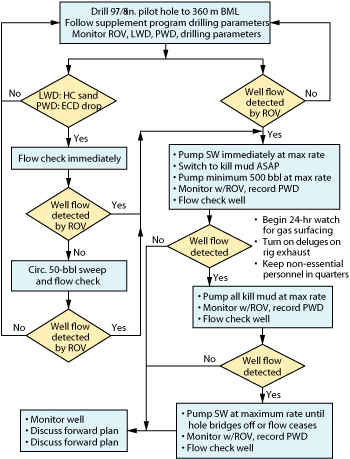 |
|
Fig. 8. The Erha-7 pilot hole drilling decision tree summarizes establishing a direct line of communication between the monitoring parties and quickens the response time.
|
|
WELL OPERATIONS
Operations on the Erha-7 well began in February 2004, with the Transocean Deepwater Discovery drillship in 1,074 m of water. A 9⅞-in. pilot hole was drilled to 360 m below mudline and no hazards were encountered. The pilot hole was subsequently opened to 17½ in., and the remainder of the riserless section was drilled and cased without incident.
CONCLUSIONS
While the wellsite operations were anti-climactic, proper planning ensured that had shallow gas been encountered, a plan was in place that would maximize the chance of a successful well control operation. The following conclusions resulted from the shallow gas planning effort.
A lack of published information exists regarding the shallow gas blowouts in deepwater. Buoyancy loss of a floating rig during a shallow gas blowout has not proven to be an issue in either research models or case histories. However, ignition of the gas plume from a shallow gas blowout appears to be unlikely because of rapid dissipation by winds.
Dynamic-kill modeling reaffirmed the value of a pilot hole for conducting dynamic-kill operations. High pump rates are critical for dynamic-kill operations, and the volume of kill mud required to affect a dynamic kill is within the limits of most floating rigs today. An analysis of shallow hazard size can provide a realistic estimate of the duration of uncontrolled flow should dynamic-kill operations fail. 
ACKNOWLEDGMENTS
The authors thank ExxonMobil Development Co., ExxonMobil Exploration Co. and the Nigerian National Petroleum Co. for permission to publish this article. Special thanks are extended to Michael W. Walker, Dennis Hining and Lothar Niggemann. Additional thanks are offered to the crew of the Deepwater Discovery for their professionalism and efforts in drilling of the Erha-7 well. This article was prepared from IADC/SPE 112631 presented at the 2008 IADC/SPE Drilling Conference held in Orlando, Florida, March 4-6, 2008.
LITERATURE CITED
The reader is directed to the complete list of references in the original paper.
|
THE AUTHORS
|
|
|
Enrique Garcia earned a BS in mechanical engineering from Texas A&M University. He joined Exxon Upstream Development Company in 1999 and has experience in floating drilling and testing operations in deepwater West Africa and, most recently, in drilling carbonate gas fields in the Arabian Gulf.
|
|
|
|
Jay Akers earned a BS in chemical engineering from Texas A&M University and an MS in petroleum engineering from the University of Texas at Austin. He has been a drilling and subsurface engineer for ExxonMobil Development Co. for 23 years. Jay has experience in drilling, completion and workover operations in the US, Norway, Nigeria, Angola and Brazil.
|
|
|
|
Jesse Holster earned a BS in aerospace engineering and a PhD in mechanical engineering from Texas A&M University. He joined Exxon Production Research in 1979, where he conducted research in a wide variety of drilling topics. In 2003, Jesse joined ExxonMobil Development Co. and served as Well Control Specialist until his retirement in 2008. Prior to his ExxonMobil career, Holster completed a tour of duty in the US Army and aerospace research work at NASA and the Southwest Research Institute.
|
|
|













